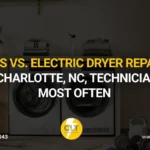[TL;DR]
The decision to repair or replace relies on three main factors: the 50% rule, appliance age, and breakdown frequency. Appliances are available with high energy savings (up to 40% or less electricity consumption) and have warranties that older models do not cover.
- Refrigerators: Replace after 12-15 years or if repair costs exceed $600
- Washing machines: Replace after 10-12 years, especially with frequent repairs
- Dishwashers: Usually worth repairing if under 9 years old
- Small appliances: Almost always replaced due to low repair costs vs. replacement
Think about the environmental impact, the warranty, and your budget. If you are unsure, get quotes from a number of repair services before making a decision.
When your dishwasher fails to clean plates or your dryer requires three loads to dry a single one, you are left with a hard decision to make. Should you repair the appliance or replace it entirely? Many homeowners struggle because they’re unsure about repair costs, appliance durability, and whether a new model offers better value. A wrong decision can be costly and leave you frustrated with frequent breakdowns. This is the reality: there is a tried and true way of making this decision comfortably. Following a few guidelines can help you make cost-effective decisions and avoid unnecessary expenses. In case you require a visit to the shop or an appliance repair service, you will know exactly what to do.
When your appliance breaks down unexpectedly, we provide same-day diagnostic services with upfront pricing. Our certified technicians help you make informed decisions about repair versus replacement.
Schedule Your Session: 704-606-9043
The Repair vs. Replace Dilemma in 2025
In 2025, the repair vs replacement decision is critical: energy costs are rising, and appliance technology is improving rapidly, making poor choices more costly.
Energy prices are increasing, and appliances are becoming more efficient and technologically advanced, making this decision more important than ever. A comprehensive study found that appliance maintenance behaviors significantly influence consumers’ decisions to repair or replace appliances.
Common scenarios homeowners face include:
- Appliances breaking down just outside warranty periods
- Multiple minor issues occurring within months
- Choosing between expensive repairs and budget-friendly replacements
- Balancing environmental concerns with financial practicality
The 50% Rule: A Quick Decision Guide
The 50% rule is simple: if repair costs exceed 50% of the price of a new appliance, it’s better to replace it. This rule is effective at the point of diminishing returns of repairing old equipment.
For Example, if your refrigerator requires a repair in the order of $800, and a similar new refrigerator would cost you around $1200, this repair would be 67% the amount that it would cost you to replace it.
When this rule should apply:
- Appliances are over halfway through their expected lifespan
- Major component failures (compressors, motors, control boards)
- Recurring issues requiring multiple service calls
When this rule shouldn’t apply:
- Appliances still under warranty
- High-end models with exceptional build quality
- Simple fixes like replacing door seals or filters
Key Factors to Consider Before Deciding
Appliance Age and Typical Lifespan
There is an expected lifespan of each appliance depending on how it is used and its built quality. The following are life spans within the industry:
- Refrigerators: 13-17 years
- Dishwashers: 9-12 years
- Washing machines: 10-13 years
- Dryers: 10-13 years
- Ovens/Ranges: 13-15 years
- Microwaves: 9-10 years
Cost of Repair vs. Replacement
Average repair costs in 2025 vary significantly by appliance type and issue complexity:
- Refrigerator repairs: $200-$600 (compressor replacement: $500-$800)
- Washing machine repairs: $150-$400
- Dishwasher repairs: $100-$300
- Dryer repairs: $100-$250
Note: Don’t forget the cost of hidden replacements, e.g., delivery ($50-$100), installation ($100-$200), and disposal of the old appliance ($25-$75).
Avoid surprise costs with CLT Appliance Repair’s transparent repair process.
Get Your Quote: 704-606-9043
Frequency and Severity of Breakdowns
Single failures are very different from recurring issues. Newer appliances are worth repairing on the condition of single-component failures, whereas recurring problems are usually systemic.
Red flags indicating replacement:
- Three or more service calls within 12 months
- Multiple systems failing
- Parts are becoming increasingly difficult to source
- Repair technicians recommend replacement
Energy Efficiency and Savings
New ENERGY STAR appliances consume less energy than those models you had previously, and this can help to lower your utility bills. But the real savings will vary depending on the age/condition of your existing appliance.
Energy improvements in new models:
- Refrigerators: New refrigerators are more efficient than 15+ years old refrigerators
- Dishwashers: Consume less water and energy as well, and do a better clean-up job
- Washing machines: Newer models are more efficient in terms of water and energy per load
Compare your current energy use with new model specs to estimate savings over the expected remaining lifespan of the appliance.
Warranty Status
Repair choices could be simple with warranty cover. The Manufacturer’s warranties usually cover parts and labour within a 1-2 year period, whereas the extended warranties can cover between 5 and more years.
When warranty tips the decision:
- Covered repairs cost only service call fees ($50-$100)
- Warranty replacement provides upgraded models
- Extended warranty terms offer better value than self-pay repairs
Environmental & Sustainability Considerations
Appliance repair minimizes electronic damage and increases the life of products. However, higher energy efficiency in the new models can cover the costs to the environment in the long run due to the low electricity requirements.
Environmental factors favoring repair:
- Functional older appliances with minor issues
- High-quality vintage appliances built to last for decades
- Availability of replacement parts and skilled repair technicians
Environmental factors favoring replacement:
- Significant energy efficiency improvements are available
- Old appliances using outdated technology
- Local recycling programs are properly handling old units
Sentimental or Special Circumstances
There are times when logic takes a back seat to the emotional value. Repair may be worth considering on high-end appliances, family heirlooms, or highly functional vintage units that do not pass financial tests.
Consider repair for sentimental reasons only when:
- Repair costs remain reasonable (under 30% of replacement)
- The appliance provides unique functionality
- Professional restoration maintains reliability
Appliance-by-Appliance Breakdown
Refrigerators
Average life: 13-17 years | Usual repair: $300-$600
With a single component breakdown before the age of 10 years, refrigerator repair is a good choice. Exchange when compressors cease in units more than 12 years of age, as repairs will likely cost more than $600.
New models include: improved temperature control, better energy-saving, and modern technology like smart connectivity.
Dishwashers
Average life: 9-12 years | Common repair cost: $150-$300
Most of the repair work on the dishwasher is a mere pump, seal, or control panel, which is not very costly. Replace units more than 8 years old that are leaking continuously or experience frequent heating issues.
New designs provide: Increased cleaning capacity, less noise, and greater water and energy efficiency.
Washing Machines & Dryers
Normal life expectancy: 10-13 years | Average cost of repair: 200-400 dollars
Front-loading washing machines have greater seal and bearing issues, yet clean better. Top-loaders require less repair and last a shorter time.
Consider replacing washer/dryer sets with transmission, drum, or control board problems after 8 years of use.
Ovens, Stoves & Microwaves
Average lifespan: 13 to 15 years (ovens), 9 to 10 years (microwaves) | Repair costs: $150 to $400.
Gas ranges typically last longer than electric ranges. The costs of repairs of microwave ovens more than 8 years old are almost the price of a new one.
Safety concerns: Older ovens may lack modern safety features like automatic shut-offs or proper insulation.
Small Appliances (Toasters, Coffee Makers, etc.)
Appliances that are small in nature are nearly always better replaced than fixed. Repairs can be the equivalent cost or even higher than a replacement, under cost of $100.
Exception: High-end small appliances (espresso machines, stand mixers) above $300 might be worth professional repair.
Tools for Deciding
Online Calculators/Decision Trees
A number of manufacturers and consumer websites provide repair-versus-replace calculators that consider the age and repair cost of an appliance, along with the energy savings and locally available utility rates. Appliance after-sales services are increasingly using data mining discoveries to enhance decision-making, which predicts repairs through product guarantee periods and usage patterns.
These tools are objective but may not account for specific situations like warranty coverage or environmental priorities.
Questions Checklist
Ask yourself these four critical questions:
“How old is the appliance?” Compare current age to expected lifespan percentages.
“How much will the repair cost?” Get multiple quotes and apply the 50% rule.
“Are new models more efficient?” Research ENERGY STAR ratings and potential utility savings.
“How often does it break down?” Track service calls and identify patterns of recurring issues.
Pros and Cons Table
| Factor | Repair | Replace |
| Cost | Lower upfront expense | Higher initial investment, long-term savings |
| Energy | Maintains current usage | 10-50% efficiency improvements |
| Environment | Reduces e-waste | Manufacturing impact, better efficiency |
| Warranty | Limited coverage | Full manufacturer protection |
| Peace of Mind | Uncertainty about future issues | Reliability for 10+ years |
| Features | Keeps current functionality | Modern conveniences and technology |
2025-Specific Trends Impacting Your Decision
Changes affecting your decision:
- Smart home integration is becoming standard in new appliances
- Utility and state rebates for ENERGY STAR qualified purchases
- Improved delivery and installation services
- Extended warranty options are becoming more comprehensive and affordable
Technology updates:
- WiFi connectivity for remote monitoring and diagnostics
- Advanced sensors preventing common failure modes
- Improved water and energy efficiency exceeding federal standards
Final Word
This systematic approach works: consider age, the 50% rule, energy savings, and your personal situation. Most homeowners benefit from replacing appliances that are over 75% through their expected lifespan, especially if repair costs exceed 40% of replacement costs. Professional advice can offer knowledge in your particular case, local utility costs, and rebates. There is no need to hurry up with the decision. Hundreds of dollars can be saved after a few days of research.
CLT Appliance Repair allows you to decide which repair will save you money in your home. Our expert technicians diagnose problems correctly and effectively communicate options available to you, and offer and complete repairs with quality parts covered by our service guarantee. We will recommend the most cost-effective solution in case your appliance only needs slight fixing, or it is time to get a new one.
Don’t let a broken appliance disrupt your daily routine. Call CLT Appliance Repair today and get back to normal fast.
Drop Us A Line: 704-606-9043
Frequently Asked Questions
How do I know whether to fix or to discard my worn-out appliance?
Generally, once the repair cost of any given appliance is more than 50% of a new one, especially when the appliance has more than half its expected life span, it would save more money to just replace the appliance altogether.
Is the repair of a very old appliance worth it?
Repair can be worthwhile for well-built appliances if costs are low; otherwise, replacement may be better due to energy efficiency, modern features, and reduced risk of future failure.
Are there any advantages to using new appliances in 2025 over the old ones?
Yes, most new appliances are less energy-demanding, have higher technology, and may have an improved warranty, saving you funds on the power expenditure and being more convenient.
Should I service a broken appliance that keeps breaking down?
Multiple breakdowns, constant issues, or big parts failures indicate replacement is better than continually fixing it.
Will the condition of the warranty influence my choice?
When your appliance remains under a manufacturer’s or extended warranty, repairs are desirable because repairs cost less or are covered.
Is repairing good for the environment compared to replacing?
Yes, repairing appliances reduces e-waste and the environmental cost of manufacturing and disposing of appliances, making it the more eco-friendly option when feasible.
Author

- John Bennett
- John Bennett is a seasoned appliance repair specialist at CLT Appliance Repair, where he brings over a decade of technical expertise and a strong commitment to customer satisfaction. With a background in electrical and mechanical systems, John has built a reputation for reliable, efficient, and honest repair services across a wide range of household appliances-including refrigerators, washing machines, ovens, and more.
Latest entries
News11/19/2025Why Your Dryer Smells Burnt: Common Causes & Fixes in Charlotte, NC
News11/19/2025Preventive Maintenance Tips to Extend Your Dryer’s Life in Charlotte
News11/18/2025Gas vs. Electric Dryer Repair: What Charlotte, NC, Technicians Fix Most Often
News11/18/2025Top 5 Signs Your Dryer Needs Professional Repair in Charlotte, NC









